Egyptian
Money
The currency of Egypt is the pound. The Egyptian pound was first put into
circulation in 1836. the Egyptian pound is
divided into 100 piastres. There are several currency units as indicated in the
following table, every banknote has two faces, one in Arabic and usually has
pictures of a well known mosque in Egypt and the other face is in English and has
pictures of ancient Egyptian figures, statues or generally monuments.
Egyptian Currency information
Since the beginning of the circulation of silver and gold coins in Egypt and
until 1834, no specified monetary unit existed to serve as a basis for the
monetary system. Only a few of the coins were minted locally. In 1834,
a Decree was promulgated providing for issuing an Egyptian currency based on a
bimetallic base, gold and silver. In 1836 the Egyptian
pound was minted and put into circulation.
The Monetary Reform Law issued in 1885 which set gold standard to become the
basis for the Egyptian monetary system, and the country had a unified currency,
the Egyptian gold pound.
It was permitted to use some foreign gold coins, particularly the Sterling
pound, at fixed legal rates. The Sterling gold pound, which was valued at more
than its gold content compared to other foreign gold coins, became the main medium of
exchange, and the Egyptian monetary system was based on the Sterling gold standard.
In 1898 the National Bank of Egypt was established and was granted, by the
government, the privilege to issue Egyptian banknotes, payable in gold for a
period of 50 years. The National Bank of Egypt started issuing banknotes on the 3rd of April
1899.
Consequently, the currency circulated in Egypt consisted of gold Sterling
pounds and Egyptian banknotes convertible into gold. This situation continued up
to 1914 when a special Decree was issued making Egyptian banknotes a legal
tender and suspending their convertibility into gold. Thus, the Egyptian pound
banknote became the basic currency unit, and the base of the Egyptian monetary
system was changed to fiduciary paper money standard. Accordingly, gold coins
were no longer used in circulation, with the result that the volume of note
issue increased from LE 11.6 million at the end of 1915 to LE 3557.0 million at
the end of 1980, and further to LE 38320.0 million at the end of 1999. In 1930,
for the first time in the history of Egyptian banknotes, a watermark was used in
issued banknotes. This was followed, towards the end of 1968, by using a
metallic thread (in notes issued by the Central Bank of Egypt) as a guarantee
against counterfeit instead of dependence on complexity of colors .Other
features against counterfeit were found in the detailed specifications of each
currency. Holograms are currently added to large denomination notes.
In July 1960 the Central Bank of Egypt was established and granted the right
of issuing
Egyptian banknotes. Several changes were introduced with respect to the
watermark, the designs shown on the notes and the colors.
The Central bank of Egypt established a printing plant for banknotes in 1968 instead of
printing them abroad. The Bank also served some Arab central
banks in printing their banknotes.
In 1977 The Central Bank of Egypt issued notes of 20 and 100 pounds in 1979
and 50 pounds in 1993.
Tips
when using Egyptian money
- Look carefully at the banknote because sometimes people are a bit confused
with Egyptian money. read the note value on the English face if you couldn't
read Arabic.
- Some Egyptian banknotes are a bit old so they look different than new
ones. Don't worry all can be used in Egypt.
- When you exchange your currency with Egyptian currency go to an exchange
company, a bank or ask at the hotel but DO NOT exchange currency from
unauthorized dealers, it is forbidden by law to exchange currency in an Unauthorized
place. You will find so many exchange offices in Egypt you might be
surprised of the how many they are.
- When you tip hotel servant, waiter ..etc use one-five pound notes.
- When you go to buy a souvenir better go alone not with a guide, and go to
several shops to ask for prices to get the best deal.
Reference : The Central Bank of Egypt
Egyptian banknotes
| Currency Unit |
|
|
| Quarter |
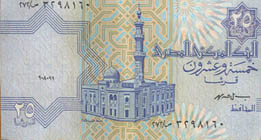 |
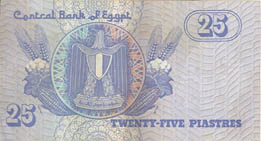 |
|
25 Egyptian piaster note or Quarter. The Arabic face
has the picture of Aisha Mosque |
The back or the English face of the Quarter has the
picture of the Quraysh Hawk the official symbol of Egypt |
| Half pound |
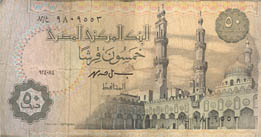 |
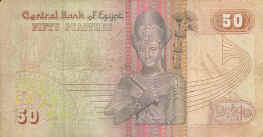 |
|
The Arabic face of the half pound note with the picture
of Al Azhar mosque |
The English face of the half pound note with the
picture of Ramses II |
| One Pound |
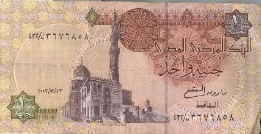 |
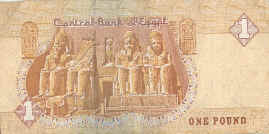 |
|
The Arabic face of the pound has the picture of Sultan
Qayetbay mosque |
The other face of the Egyptian pound has the picture of
Abu Simbel temple in Aswan |
| 5 Pound note |
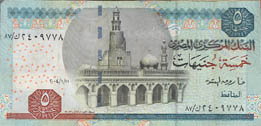 |
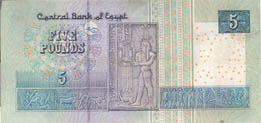 |
|
The Arabic face of the five pound note with the picture
of Ahmed ebn Tolon Mosque |
The back of the 5 pound note |
| 10 Pounds |
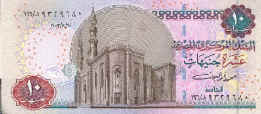 |
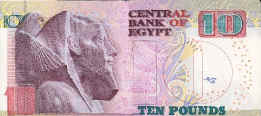 |
|
The Arabic face of the 10 pound note has the picture of
El Refaee moque |
The English face of the 10 pound note has the picture
of Khafre with the eagle |
| 50 Pounds |
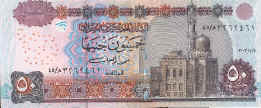 |
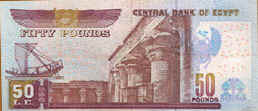 |
|
The Arabic face of the 50 pound note has the picture of
Abu Hreba moque |
The English face of the 50 pound note has the picture
of the Karnak temple |
| 100 Pounds |
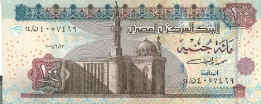 |
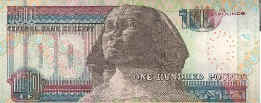 |
|
The Arabic face of the 100 pound note has the picture
of Sultan Hassan mosque |
The back of the 100 pound note has the picture of the
Sphinx |
| 200 Pounds |
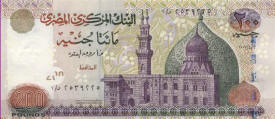 |
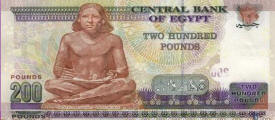 |
| |
The Arabic face of the 200 pound note has the picture
of Qanibay Mosque |
The English face of the 200 pound note with the statue
of the Egyptian scribe |
Egyptian coinage
Egyptian coins are made of copper and silver alloys,
round in shape and have embossed pharaonic and Islamic style
pictures and calligraphy. Coins replaced the banknotes of
values less than 5 pounds. Coins are difficult to carry so
be careful when you have some of them in your pocket, you
can put them in a wallet with a zippered pocket or coin case
(which is rare ) or you can put them in your jacket pocket.
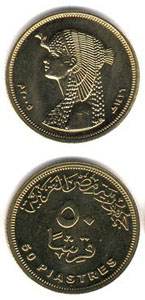 Half Pound Half PoundCoin & Banknote The 50
piastres coin is produced from specific metals.
banknotes of this unit have been cancelled by the
Egyptian financial authorities a few years ago. |
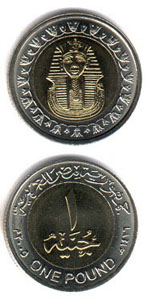 One Pound One PoundCoin & Banknote A few
years ago the Egyptian pound was issued only in
banknote but now you can only find it as a coin as
the Egyptian government decided it is cheaper to
produce coins and cancelled printing of the one
pound note. |
Note:
Some companies in Egypt have the acronym S.A.E beside their names, so What
does SAE stand for in Egypt? Societe Anonyme Egyptienne SAE stands for
Societe Anonyme Egyptienne (French: Egyptian Joint Stock Company)
Back to Egypt guide
If you need to send flowers or gifts to Egypt you can order online in Arabic or English language at Todayflowers.com to send flowers within Egypt. You can also deliver flowers worldwide. Fast delivery of flowers by first class Egypt flower delivery service. Whether you want flowers delivered in Cairo or to New York, Todayflowers.com enables you to order flowers and have them delivered the next day. In addition to Egypt flower delivery you can also order cakes, teddies and chocolates. |